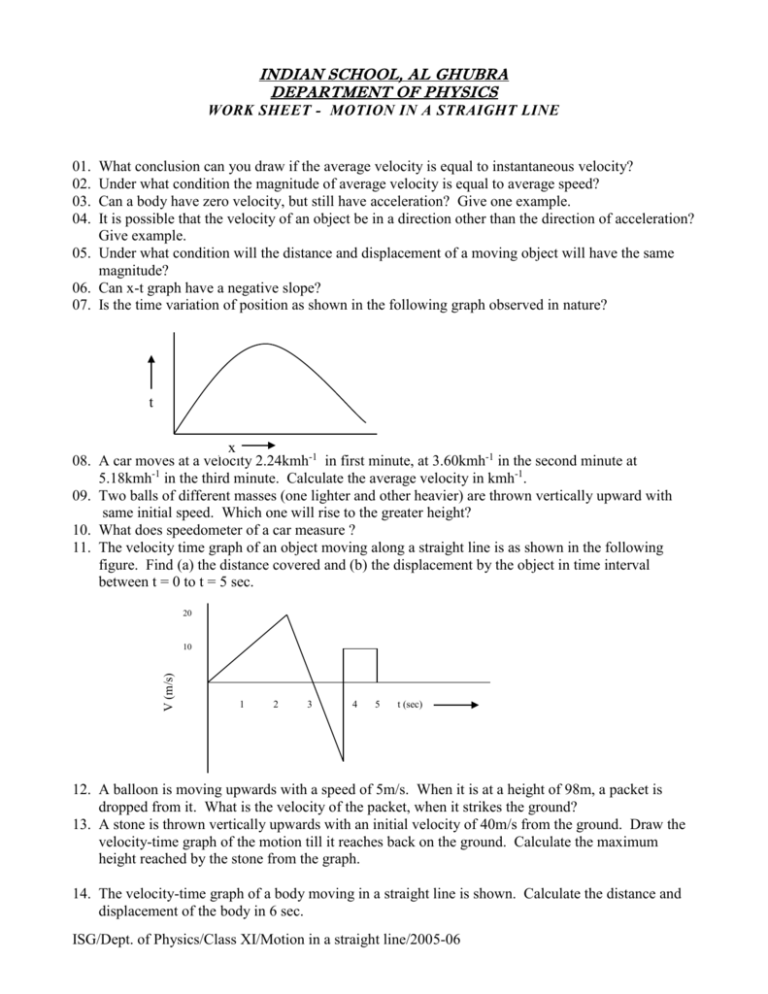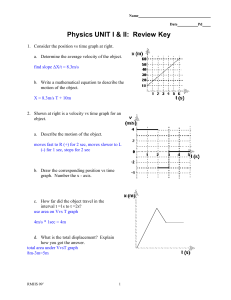Assignment2-I-05 - Indian School Al Ghubra
advertisement

INDIAN SCHOOL, AL GHUBRA DEPARTMENT OF PHYSICS WORK SHEET - MOTION IN A STRAIGHT LINE 01. 02. 03. 04. What conclusion can you draw if the average velocity is equal to instantaneous velocity? Under what condition the magnitude of average velocity is equal to average speed? Can a body have zero velocity, but still have acceleration? Give one example. It is possible that the velocity of an object be in a direction other than the direction of acceleration? Give example. 05. Under what condition will the distance and displacement of a moving object will have the same magnitude? 06. Can x-t graph have a negative slope? 07. Is the time variation of position as shown in the following graph observed in nature? t x 08. A car moves at a velocity 2.24kmh-1 in first minute, at 3.60kmh-1 in the second minute at 5.18kmh-1 in the third minute. Calculate the average velocity in kmh-1. 09. Two balls of different masses (one lighter and other heavier) are thrown vertically upward with same initial speed. Which one will rise to the greater height? 10. What does speedometer of a car measure ? 11. The velocity time graph of an object moving along a straight line is as shown in the following figure. Find (a) the distance covered and (b) the displacement by the object in time interval between t = 0 to t = 5 sec. 20 V (m/s) 10 1 2 3 4 5 t (sec) 12. A balloon is moving upwards with a speed of 5m/s. When it is at a height of 98m, a packet is dropped from it. What is the velocity of the packet, when it strikes the ground? 13. A stone is thrown vertically upwards with an initial velocity of 40m/s from the ground. Draw the velocity-time graph of the motion till it reaches back on the ground. Calculate the maximum height reached by the stone from the graph. 14. The velocity-time graph of a body moving in a straight line is shown. Calculate the distance and displacement of the body in 6 sec. ISG/Dept. of Physics/Class XI/Motion in a straight line/2005-06 V (m/s) t (s) 15. A particle starts from rest at t = 0 and undergoes an acceleration as shown in figure. a(m/s2) 3 1 2 3 4 5 t(sec) -3 (a) Draw a neat sketch showing the velocity of the particle as a function of time during the interval from 0 to 4 sec indicating each second on the abscissa. (b) Draw a neat sketch showing the displacement as a function of time during the same time interval. 16. Two balls are projected simultaneously with the same speed from the top of a tower, one vertically upwards and the other vertically downwards. They reach the ground in 9s and 4s respectively. Calculate the height of the tower. (g = 10m/s2) 17. A car covers the first half of a certain distance with a speed v1 and the second half with a speed v2. Calculate the average speed during the whole journey. 18. Prove that for a body moving with constant acceleration, the distances traveled in successive equal time intervals are in the ratio 1: 3: 5: 7: ………. 19. A body travels 200 cm in the first two seconds and 220 cm in the next four seconds. What will be the velocity at the end of seventh second from the start? 20. The displacement “x” of a particle moving in one dimension, under the action of constant force is related to time by the equation t x 3 where ‘x’ is measured in metres and ‘t’ in seconds. Find the displacement when the velocity is zero. 21. A ball is projected vertically upwards from the ground with a velocity of 20m/s. (a) how high will it go? (b) How long will it take to reach the highest point? (c) When will it return to ground? (d) With what velocity will it return to the ground? Take g = 10 m/s2. 22. A particle is projected vertically upwards. If t1 and t2 be the times at which it is at a height ‘h’ while ascending and descending respectively, Show that h = ½ gt1t2. Also find the velocity of projection. 23. From the top of a cliff 30m high, a stone is dropped. At the same instant, another stone is projected vertically upwards with a speed of 30m/s. After how many second and at what height from the ground will the stones cross each other. 24. A particle initially at rest, starts moving in a straight line with acceleration a= 6t + 4 m/s2. Calculate the distance covered by it in 3 seconds. Assume that the constant of integration is zero. 25. If x, y and z are the distances traveled by a particle moving with a constant acceleration during the lth, mth and nth second of its motion respectively, show that x (m – n) +y (n – l) + z (l – m) = 0 ISG/Dept. of Physics/Class XI/Motion in a straight line/2005-06 Indian School, Al Ghubra Department of Physics Answer key to the worksheet on Motion in a straight line 01. 02. 03. 04. 05. 06. 07. 08. 09. 10. 11. Uniform motion Motion in a straight line Yes. In vertical motion at the highest point, velocity is zero. But acceleration is “g”. It is possible. In circular motion, centripetal acceleration is perpendicular to the velocity. When the object moves along a straight line and always in the same direction. Yes. It happens when the velocity of the body is negative. No. It is not possible. 3.67 km/h Both the balls will rise to the same height Instantaneous speed (a) distance covered = ½ 3 20 + ½ 1 20 + 1 10 = 50m (b) displacement = ½ 3 20 - ½ 1 20 + 1 10 = 30m 12. u = -5m/s, g = 9.8m./s2 and S = 98m. S = ut + ½at2. ; 98 = -5t + ½t2.; on solving t = 5 sec. ; v = u + gt v = 44m/s. 13. V = u – gt; 0 = 40 – 10t t = 4 sec. The stone takes 4 sec to reach the top. Maximum height = Area of OAB = 80m. V(m/s) 20 4 t (sec) 14. Distance = 40 + 20 + 20 = 80 m; Displacement = 40 – 20 + 20 = 40m. 15. 16. 180m 2v1v 2 v1 v 2 19. 200 = 2u + ½ a (22); 420 = 6u + ½ a (62) u = 115cm/s and a = -15cm/s2. V = u + at v = 10 m/s. 20. t x 3 x t 2 - 6t 9 v 2t - 6. If v 0, 2t - 6 0 and t 3. When t 3, x 0 21. u = 20m/s. v = u – gt 0 = 20 – 10t. t = 2 sec. v2 = u2 – 2gh 0 = 202 – 2 10 h 20h = 400, h = 20m. It will return after 4 seconds. 17. The average velocity = ISG/Dept. of Physics/Class XI/Motion in a straight line/2005-06 22. h ut 1 1 2 1 1 gt 1 ; h ut 2 gt 22 u(t 2 - t 1 ) g(t 22 - t 12 ) 2 2 2 1 1 g(t 1 t 2 ). Substituti ng this value in one of the equations, we get h gt 1 t 2 . 2 2 23. t = 1 sec and h = 25 m. u 24. a 6t 4. v (6t 4) dt 3t 2 4t. x (3t 2 4t) dt t 3 2t 2 . displaceme nt at t 3 sec 33 2 3 2 45 m a a a 25. x u (2l 1); y u (2m 1) and z u (2n 1) 2 2 2 x - y a (l m); y - z a(m n) and z - x a(n l ) z(x - y) x(y - z) y (z - x) 0 az( l m) ax( m n) ay( n l ) z( l m) x( m n) y( n l ) 0. ISG/Dept. of Physics/Class XI/Motion in a straight line/2005-06








